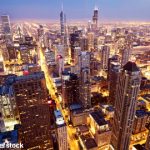I arrived in Chicago on a delightfully cool and crisp Sunday afternoon just as the Monsters of the Midway were bashing heads with the Carolina Panthers out at Soldier Field. After I checked into the hotel, I decided to amble around downtown to take in the sights and sounds and imagine the look of the city when the streets would overflow with rheumatologists instead of Bears fans wearing blue and orange jerseys emblazoned with “Payton 34” and “Urlacher 54.”
I started with a stroll down Michigan Avenue, which is known as the Magnificent Mile and is truly one of great boulevards around, leagues ahead of Ninth Street in Durham (my home town) and a strong rival to New York’s Fifth Avenue. New York and Chicago are different places, however. New York is a great world city while Chicago is a great American city. Michigan Avenue emits a distinct blend of openness, rawness, and rowdiness that is prototypically American, even if it lacks the glamour and sophistication of Fifth Avenue.
My path around the city on that Sunday afternoon was a bit circuitous because I wanted to get a better sense of the real Chicago, and I crisscrossed Michigan Avenue several times. The downtown of Chicago is in transition, and giant high-rise apartment buildings ascend from land that was once the site of department stores and factories. Rents downtown must be absolutely stratospheric, but hey, from the 34th floor, you can look out your window and gaze at the lake shimmering in the glow of the silver-white moon.
While Michigan Avenue has much to justify its moniker as magnificent—Ralph Lauren, Ferragamo, and Niemann Marcus—just off to the side on Wabash and Rush, the mile is less than magnificent. Walking along the street, I saw a tired looking man wearing a black nylon parka and a baseball cap that said Comcast. In one hand he held a cup for money. In the other, he had a sign that said, “I am homeless and have a 6 year old child. Please help.” Attached to the sign was a photo of a child, who looked quite miserable. On Wells Avenue, another man slumped in a wheelchair, his left leg encased in an external fixation device that some orthopedist had dutifully assembled from shiny metal parts.
Big cities always have beggars, panhandlers, and homeless people who populate the same terrain as the high-end stores that feature the latest fashions from Paris and Milan. People from cities usually avoid those asking for money or, eyes averted, quickly pass by even if they could spare a quarter or a dollar (and often a lot more). The culture says to turn a blind eye to street people in need and I have been taught to do that myself.
